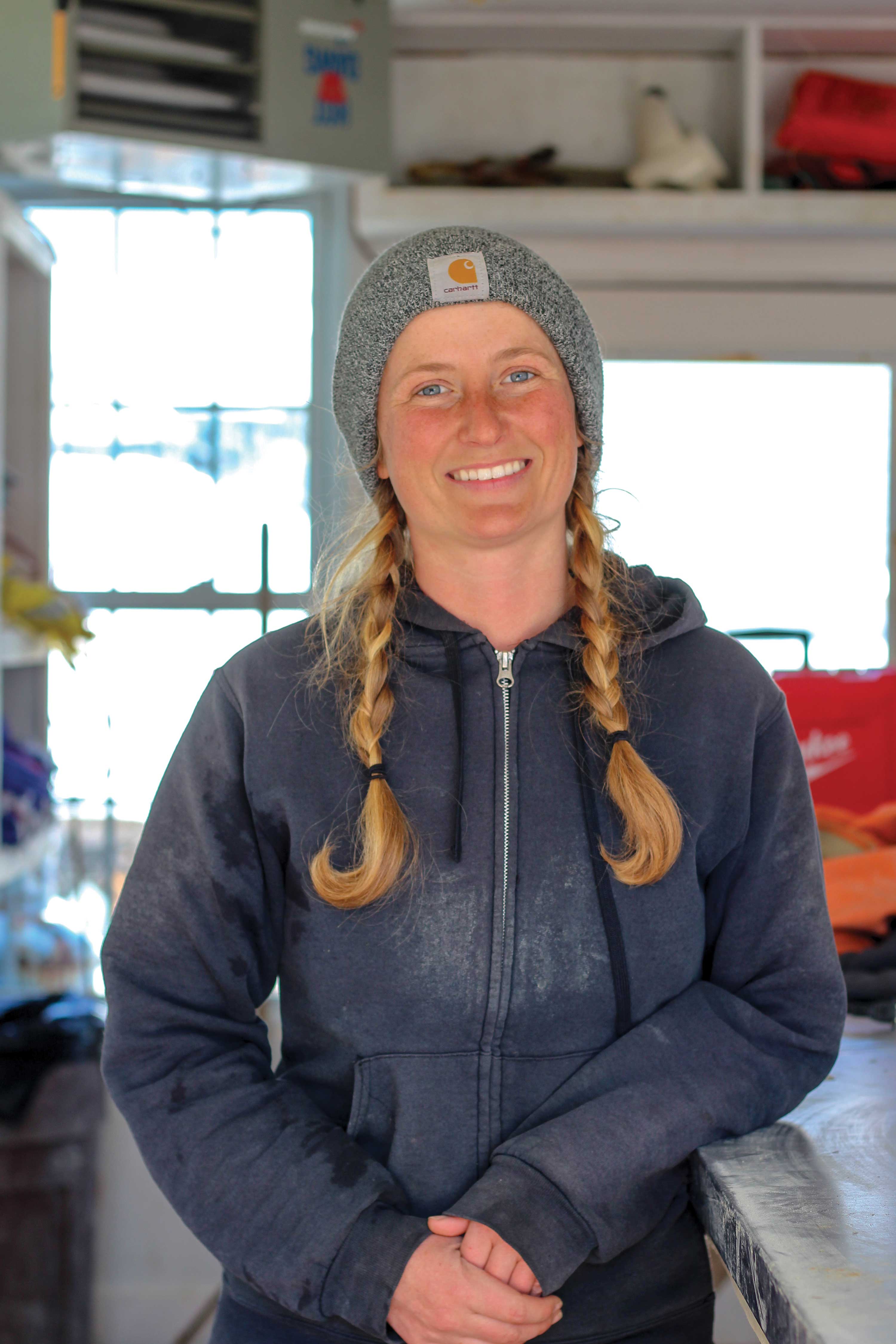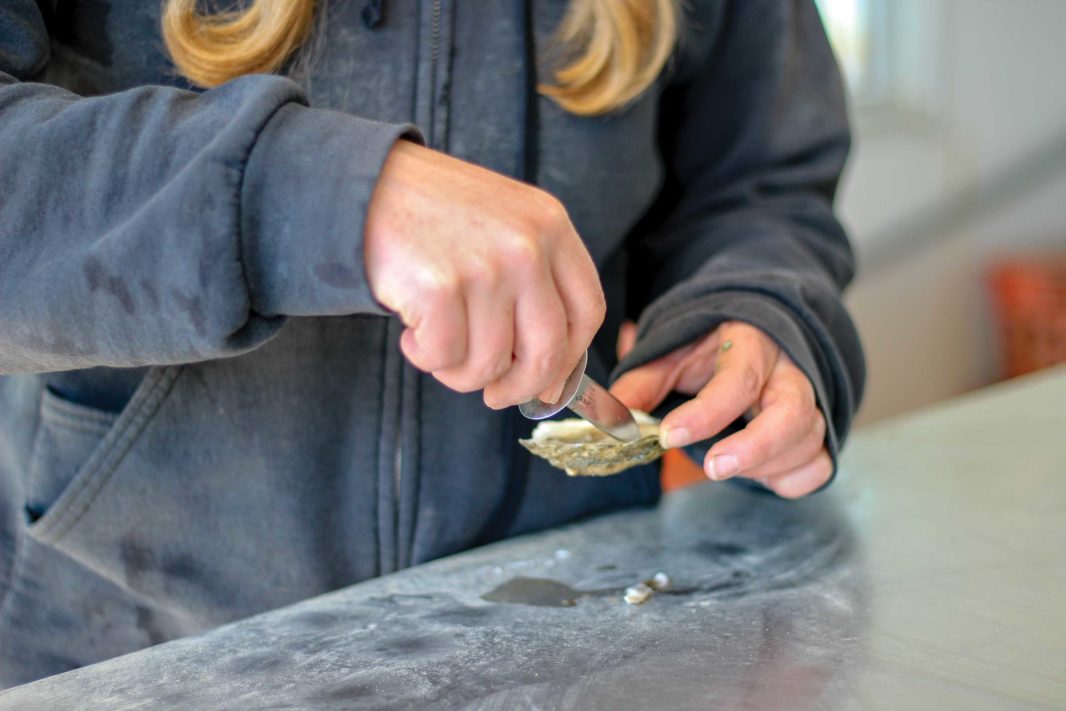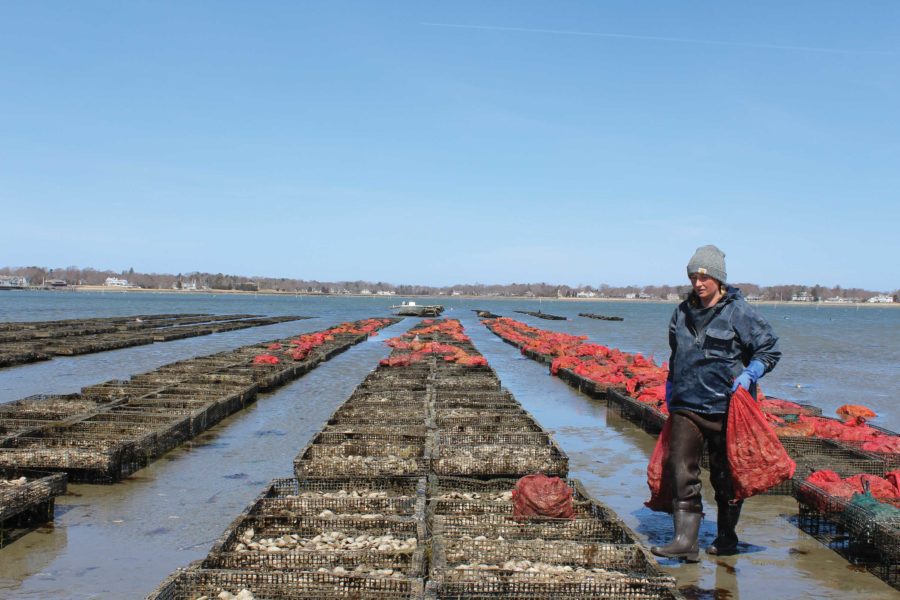Ursula Balmer’s day can start any time between 4 a.m. and 9 a.m. It all depends on the tides.
Balmer has been part of the farm crew at Island Creek Oysters in Duxbury, Massachusetts, for over five years. She runs the team in charge of all the Island Creek and Row 34 oysters that end up in well-iced serving dishes at restaurants in Boston and across New England.
When Balmer first joined the farm team, she was the only woman, but now she says there are a lot of ladies on board, and, in fact, female workers comprise the hatchery (where oysters are spawned) almost entirely. Ironically, most of them don’t eat seafood.
When Balmer first joined the farm team, she was the only woman, but now she says there are a lot of ladies on board, and, in fact, female workers comprise the hatchery (where oysters are spawned) almost entirely.
“Welcome to my office,” says Balmer, grinning as she steps into a small wooden structure dominated by an industrial metal table and rows of XL waders. Balmer studied marine biology in college, but once she discovered oyster farming it was love at first shuck.
 Wearing a dark blue windbreaker with her blond hair in sensible braids, Balmer looks every bit the part of a fearless seafarer.
Wearing a dark blue windbreaker with her blond hair in sensible braids, Balmer looks every bit the part of a fearless seafarer.
Island Creek is a unique workplace in that the oysters are spawned, grown and harvested all in one place. Because of the expensive equipment and time commitment required, most oyster farmers buy their seed rather than produce it.
Basically, it works like this. Once the seeds are spawned in Island Creek’s on-site hatchery, they’re distributed into mesh bags. At the early stages, the seeds just look like grains of sand. Small mesh bags hold up to 1,500 oysters, by Balmer’s estimate. As they grow in the water, they are transported into larger bags until, eventually, they’re put in trays on the ocean floor until they can be harvested. It typically takes an oyster 18 months to grow from seed to harvest.
The farm grows three types of oysters, Island Creeks, Row 34s and Aunt Dottys. The oysters taste different depending on where they’re grown and how far into the water they are submerged.
“End of April and into May is when we start getting busy,” says Balmer. “The oysters start growing mid April. There has to be algae in the water for them to grow, and the water has to be the right temperature.”
Summer also heralds the opening of Island Creek’s on-site raw bar overlooking the water where the oysters grow, as fantastic a nod to farm-to-table eating if ever there was one. Soon, the area where Balmer stands will be filled with customers sipping rosé and slurping fresh Island Creeks.
We’ve all heard the myth that oysters are only safe to eat during months that end in “R.” So, what does that mean for our summertime dozen?
“That was kind of an older saying, for when refrigeration wasn’t really a thing,” says Balmer. “Oysters do fatten up at the end of fall so they can have enough sugars to last them the winter. Technically, they taste a little bit better in the fall and the winter. But, you can eat oysters all year round.”
Thank goodness.

Balmer’s days vary not just with the tides, but also with the stages of production. During growing season one thing is pretty constant: Checking in on and harvesting the oysters. She and her colleagues drive a boat out to the oysters while the tide is on its way out. Once it’s out, they can walk in their waders among the oysters to see how they’re growing, and harvest them either by hand or by hauling the oyster crates onto the boat.
Because the water has become shallow, they often can’t take the boat back to shore until the tide comes in, which can be hours. “Definitely there’s been a couple times when the boat is stranded and a thunderstorm rolls in, and you’re like, ‘Alright, I’m just gonna pretend this isn’t happening,’” says Balmer. “We try not to be on the water for that, but sometimes it’s unpredictable.”
The job certainly has its risks, and it requires a lot of intensive physical labor. But, Balmer seems right at home out in the ocean, sun on her face and salty wind in her hair.
The job certainly has its risks, and it requires a lot of intensive physical labor. But, Balmer seems right at home out in the ocean, sun on her face and salty wind in her hair. Plus, she gets to snack on oysters on the daily, without the urban restaurant price markup.
“If we have a super early tide we’ll run out with headlamps and wait for the sun to rise,” says Balmer. Oysters fresh from the ocean and a front row seat for the sunrise? Not a bad benefits package.



 4 min read
4 min read

